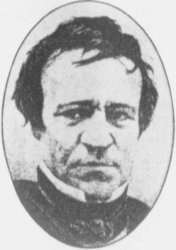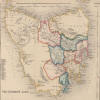 Patrick
O'Donoghue (died 1854), also known as Patrick O'Donohoe, from
Clonegal, County Carlow, was an Irish Nationalist revolutionary
and journalist, a member of the Young Ireland movement.
Patrick
O'Donoghue (died 1854), also known as Patrick O'Donohoe, from
Clonegal, County Carlow, was an Irish Nationalist revolutionary
and journalist, a member of the Young Ireland movement.

In the aftermath of the failed Young Irelander Rebellion at
Ballingarry, County Tipperary, in July 1848, he was placed in
October 1848, before a British 'Special Commission' at Clonmel in
County Tipperary and sentenced to death for treason. As with
other prominent Young Irelander's, this was later commuted to
transportation for life to the penal colony at Van Diemens Land
(Tasmania).
Source: From Wikipedia, the free
encyclopedia
The following information on Patrick
O'Donoghue was written and researched by Cara.
Patrick O'Donoghue
was indeed born in Clonegal Co
Carlow Ireland, a man who has been really overlooked when it
came to his involvement in the movement that was to become a
household word in Tasmania (Van Diemens Land), Australia, well
in particular, within and around the area of Westbury in
Tasmania.
 Patrick
became involved in the Young Ireland movement when the split
within the Repeal Association, between the young and the Old
Ireland took place in the July of 1846.
Patrick
became involved in the Young Ireland movement when the split
within the Repeal Association, between the young and the Old
Ireland took place in the July of 1846.
In the Autumn months of 1846 the hope of a possible
reconciliation with the O’Connellite repealers was hoped for and
many remonstrant meetings were held in Dublin, as this is where
Patrick was by now, but by December the seceders has decided to
form their own association and to be called the Irish
Confederation, and it was at the first meeting of this
association at the Rotunda on the 13th January 1841 he had been
made a member of this association, but by January 1848 he had
been struck off.
Patrick O’Donoghue claimed, both John Mitchell and Thomas
Francis Meagher asked him to permit his name to be re-instated
which he declined.
He indeed became a member of an established club in 1848,
which had among its members one Charles Gavan Duffy. (Grattan
Club).
He was not a good member as he did not attend meetings on a
regular base and when he did he objected to the ideas put
forward by the Secretary, Mr. P. J. Barry which he ( Patrick )
claimed were extremely violent.
This did show Patrick to me as non-violent man.
John Mitchell had been transported, to the land down under,
arriving in Tasmania in the May of 1848.(His escape from
Tasmania to be much written about here).
The Clubs or Associations had been calling on all people to
secure arms in preparation for an insurrection in the Autumn so
by July 20th 1848 the government reacted to the increased
political activity, and issued a proclamation ordering the
people of Ireland to surrender their arms.
The news of this reached Dublin by Saturday the 22nd that the
Habeas Corpus Act was suspended and that a warrant had been
issued for the arrest of William Smith O’Brien a principal
leader of the Confederation Movement (another contender for Van
Diemen's Land).
Patrick attended a meeting of the Grattan Club the next day
and at which Patrick Barry and his brother made two violent
speeches, which (he) Patrick condemned.
It is hard to understand how it was then, that by 29th July
Patrick had become so involved with the movement within Co
Tipperary.
In a book named “The Felon’s Track" by Michael Doheney he
wrote “as an episode in this history, the fat of Patrick
Donoghue is singular and startling,”
A warrant had been issued for Patrick’s arrest by Monday July
24th along with several other Young Irelander's, having no
knowledge of the truth of this warrant, Patrick called on many
of the Young Irelander's but he learnt nothing really, it was
all very vague, but he was relied upon to deliver papers to
Smith O’Brien who had fled the city.
Patrick proceeded to Kilkenny but found that Smith O’Brien
had moved on so being under suspicion by the Kilkenny
Confederate Club they arrested him and delivered him to Smith
O’Brien.(under escort by James Stephen (future Fenian Leader)
and Patrick Cavanaugh).
The shortened version is that Patrick O’Donoghue threw in his
lot with Smith O’Brien and by August 5th he had been arrested,
his trial being set before a special commission on October
16th.-
16 Oct 1848. Clonmel
The Attorney General contended that having joined the ranks
of the rebel Army, Patrick was equally guilty with the leaders
and must be supposed to have had the same objects in view and to
have adopted their plans.
Found guilty of treason – Patrick O’Donoghue complained that
a jury of political opponents had been empanelled to try him.
To counter the startling doctrine that he was guilty of
treason by association with O’Brien.
Patrick simply added, “It is not fit, at this solemn occasion
to defend my opinions or conduct. I will, therefore, only say
that those opinions have always been tolerant, sincere and
consistent.”
The death penalty was commuted and he was transported for
life along with several of his fellow Irish Patriots.
Leaving Richmond Prison the four patriots concluded their
farewell address with the words
“We owe it to our feelings to declare whatever may be the
sacrifice we incur by devotion to its interest our latest
aspiration will be prayer for the prosperity, honour and
independence of Ireland.
 Aged
just 40 Years Patrick O’Donoghue set out to begin a new life in
Tasmania (Van Diemen’s Land) .
Aged
just 40 Years Patrick O’Donoghue set out to begin a new life in
Tasmania (Van Diemen’s Land) .
An Ardent and excitable temperament, so said John Mitchell,
and it was this temperament that was to cause him more hardships
in Tasmania than any other of the political prisoners who came
here in 1848.
After his arrival in Hobart Town he was determined to be self
sufficient, he had hoped to gain employment in a solicitor’s
office as a clerk, but it appears no such opening appeared for
him to fulfil this.
He then decided to commence a weekly newspaper, the “Irish
Exile,” and with this source he created himself trouble.
He of course met with advice from his Patriots to leave well
alone, but he was Patrick O’Donoghue, he had an opinion and he
wished to voice it. So the “Irish Exile,” appeared on what we
now call Australia day, 26th January 1850, and to the surprise
of many it met with considerable success.
Irish History, and patriotic poetry were prominent features
and the Nation was quoted extensively
But by December of 1850 he was in breach of regulations, and
the special police arrived to take him to Tasman Peninsula.
Ill health detained his immediate removal and so he was
placed under guard in his home, but he was a cheeky Irish man,
and through one way or another he managed to arrange for the
paper to be published on Christmas Eve and then he turned
himself over to the law.
He served 6 months penal time and upon arriving back in
Hobart Town was marched to the penitentiary where he received
his parole for six months and a ticket of leave, he was ordered
to leave the city within in a week, and to reside in the
interior of the island.
O’Donoghue in his own words said he could “Starve at
Leisure.”
After 3 months of residing in Oatlands, Patrick received
permission to live in Launceston (which is in the North from
Hobart).
His first attempt at escape from the island was foiled, and
he was returned to gaol until he renewed his promise to complete
his term, and for a while after that attempt he lived quietly in
Launceston as a guest with Rev. Thomas Butler.
He indeed lived for a period of time, a very real and
tranquil life, but by late 1852 he was again defending his Irish
friends Honour as a uncomplimentary remark had been made on one
Charles Gavan Duffy. He made some threats and was once again
delivered to a penal institute, where he was placed in a chain
gang. But on November 1st 1852 he was ordered to Launceston, but
on the way he became misplaced, lost, disappeared, and after 6
weeks of being missing he was stowed away on the “Yarra Yarra”
and arrived in Melbourne by the 22nd of December, from there to
Sydney and on to Tahiti and then on to San Francisco on the
“Otranto.”
A freeman in America for two years but he died in New York
City on 22nd January 1854.
 I
am sending you a photo of the headstone of Patrick O'Donoghue
in Green-Wood Cemetery, Brooklyn, NY. The site in Clonegall
where Patrick was born in now the Sha-Roe Bistro, a
Michelin-rated restaurant. I hope this is helpful.
I
am sending you a photo of the headstone of Patrick O'Donoghue
in Green-Wood Cemetery, Brooklyn, NY. The site in Clonegall
where Patrick was born in now the Sha-Roe Bistro, a
Michelin-rated restaurant. I hope this is helpful.
From Patricia Phelan Aug 2017
Fact or Fiction
I have been told that his wife arrived one week after his
death in 1854 and I would love to know what happened to her boy,
and indeed what became of Mrs. Patrick O’Donoghue.
* this is a very short version of my research of this man.
- Source: Written and researched by Cara.
- Image of map from Wikipedia. Image
of house & plaque from Cara.
-
- Read more on the
website about
Patrick O'Donoghue
Please
report any images or links which do not open to
mjbrennan30@gmail.com
- The
information contained in these pages is provided solely
for the purpose of sharing with
others researching their ancestors in Ireland.
© 2001 Ireland Genealogy Projects,
IGP TM
By Pre-emptive Copyright - All rights reserved
TOP OF PAGE